
Many people who suffer from debilitating foot/heel pain need to augment their regimen with alternative treatment options to deal with their condition. Fortunately, there are various options such as foot compression socks and sleeves to provide that extra pressure along the leg ligament.
These socks can prove to be extremely valuable, especially if you don’t have time to put pressure on your heel all day long. These socks along with proper support shoes could be beneficial to anyone who sits for long periods or their work entails standing for long periods.
Before you can go purchase your compression socks we will take you on a journey through the world of compression stockings. You will understand what they are, who uses them and the benefits of wearing compression stockings.
What are Foot Compression Socks?
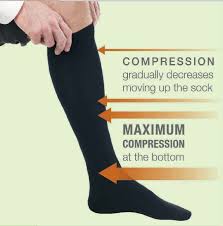
These socks are medical grade socks that are designed to help the movement of blood. The support provided by these socks in different levels which range from mild (8-15 mmHg), Medium (15-20 mmHg), Firm (20-30 mmHg) and X-Firm (30-40 mmHg).
Reasons to getting a compression socks may vary depending on the condition or symptoms. Below are some of the symptoms you may require to get yourself compression therapy:
- Pregnancy-related swelling
- Varicose Veins
- Lymphedema
- Swelling, blood clots, or pain in the lower legs known as DVT (Deep Vein Thrombosis)
- Poor Circulation from sitting for long periods
- Post-Sclerotherapy and post-surgical treatment
These socks are medical-grade stockings and can be used as a preventative measure to maintain healthy legs for anybody who spends most of their time on their feet. Quite simply when standing for long periods, gravity forces increase the pressure in the veins of the lower limbs where the impact of the forces happens mostly at the ankle and decreases gradually up the leg and body.
This pressure depends on the vertical distance of the column of blood from the foot to the heart. This is why compression hosiery are designed with the most pressure centered at the ankle and decreases as you move up the leg thus countering the effects of the venous pressures.
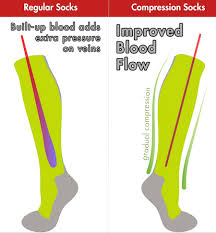
These socks are put in the morning upon rising before any significant swelling can occur and removing it at night. Throughout the day these socks prevent blood from pooling in leg veins, in turn, helping the overall blood circulation and eliminate any leg swelling.
There are many types of compression socks available that you can buy without a prescription and they do offer a wide range of benefits. Lower compression gradients do not require a prescription from a doctor. However, with higher graduated compression stockings, you require to consult your health care provider to find out if they are right for you.
How Do Foot Compression Stockings Work?
Compression stockings are like tights but made from different materials and serve different purposes. While ordinary socks are worn to protect the legs and for style, compression socks are elastic and designed to fit around the ankles and legs. They are tight around the ankle and less tight around the calves.
The pressure created by the socks will help push the lymph fluid and blood up the leg allowing for blood flow from the heart to the legs. They not only improve blood flow but reduce pain and swelling. They are recommended in the prevention of DVT as the pressure stops the blood from pooling and clotting.
How to Use Compression Socks
If you are experiencing leg trauma or had surgery, then your doctor may prescribe compression socks during the and after a hospital stay. You can also buy this product from a medical supply store or pharmacy.
These socks are won after DVT diagnosis to reduce some of the discomfort or swelling. Previously the socks were won after acute DVT to negate post-thrombotic syndrome but this is no longer the case.
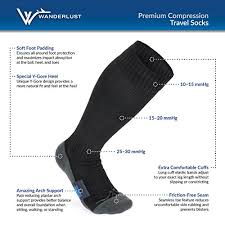
These socks can also be used as a preventative measure, and for the best results, you need to wear the socks the first thing in the morning before you stand. Putting the compression socks after standing and moving around can cause swelling and at which point it can become harder to put on the socks. Bear in mind that you will need to remove the socks before taking a shower.
Since these socks are tight and elastic, applying lotion to your skin before wearing them will help the material glide up your leg. But make sure that the lotion is well absorbed into the skin before putting on the socks.
Putting on compression socks will require grabbing the top of the socks, rolling it down toward the heel, putting your foot inside the socks and slowly unrolling the socks up your leg.
It is recommended that you continuously wear socks throughout the day and only removing it during bedtime. Taking care of the socks will require washing the socks with mild soap and air drying it. You should also replace your compression socks every four to six months.
Putting on Compression Hosiery

It takes a little practice to put on support stockings. This is because the socks are tight and offer a certain level of pressure on your feet. To put on these stockings follow the following steps to wear them with ease:
- Insert your hand into the stocking as far as the heel pocket
- Grasp the center of the heel pocket and turn the stocking inside out to heel area.
- Carefully position the socks over the foot and heel. Be sure the heel is centered in the heel pocket.
- Begin pulling the body of the stocking up around the ankle and calf. The stitch change should fall between one and two inches below the bend of the knee.
- When applying the thigh portion of the stocking, start rotating the stocking inward so the gusset is centered over the femoral vein. The gusset is placed slightly towards inside the leg and top band should rest in gluteal fold. Smooth out any excess material. Pull the toe section forward to smooth the ankle and instep.
Types of Compression Hosiery
Finding a compression stocking can be difficult if you do not have the knowledge to choose the right support stocking. This is why we inform you about the different compression socks available in the market and their differences.
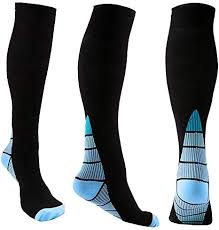
Some may be purchased on an online compression store or over the counter from your local pharmacy while others need a doctors prescription. The lower compression strengths are sold over the counter while the strong compression strengths need a medical practitioners prescription.
There are three primary types of compression socks. These are:
- graduated compression socks
- non-medical support socks
- anti-embolism socks
Graduated Compression Socks
In graduated socks, the compression level is strongest at the ankle and the pressure gradually decreases towards the top. They are created to meet certain strength and length for mobility. They generally require professional fitting.
Socks which end below the knee helps limit peripheral edema or leg swelling as a result of fluid buildup. There are variants which extend to the thigh or waist to reduce pooling of blood in legs thus preventing orthostatic hypotension. Some compression socks suppliers offer personal preferences such as open or closed-toe and color.
Non-Medical Support Socks
These socks do not necessarily require a prescription. They include flight socks and elastic support as a potential relief for aching legs. You can purchase these socks online or your local pharmacy.

Anti-Embolism Socks
These types of socks help in reducing the possibility of deep vein thrombosis. Just like the graduated socks, they offer gradient compression but the level of compression differs. These types of socks are designed for those who are immobile.
Choosing a Foot Compression Hosiery
There are many varieties of compression socks available in the market and they vary in length, style, material, size and compression strength. It can be overwhelming when trying to choose your support socks. These are the factors which will guide you when searching for compression socks. If you are wearing compression socks due to a medical condition, your health care provider is the best resource to have.
Size
You need to find the correct size when selecting these socks, many retailers will help with this by providing a measurement chart which will instruct you on how to best determine your size. These charts depend on what kind of compression sock you desire. For example, your shoe size will greatly influence a knee sock or over the knee sock. Full compression socks are usually sized regular in department stores. The size is based off a ratio between weight and height. Other may require measurements for ankle circumference, calf-length and calf circumference.
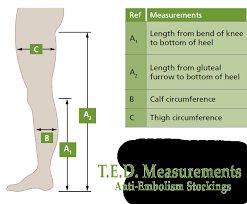
Compression Strength
The level of compression you need will depend on your need for compression socks. the standard levels as mentioned include:
- Moderate compression, 20-30 mmHg – great for legs which experience moderate swelling and varicose veins because of pregnancy or another condition. You can also wear them when your legs feel tired and heavy.
- Firm compression, 30-40 mmHg – these are usually required when you have moderate to severe varicose veins, moderate edema, or after vein treatment such as vein stripping. They also come in handy for combating lymphedema.
- Extra firm compression, 40-50 mmHg – they help with severe edema, or varicose veins, chronic venous diseases or severe post-thrombotic syndrome.
- Heavy compression, 50-60 mmHg – this is the strongest standard compression level and is primarily used in relieving Post Thrombotic Syndrome and lymphedema.
Material
The material used to make the compression socks will depend on the need for the compression socks. Some are made of lycra, rubber or spandex and they come in different lengths like knee, thigh or full. If your need for compression socks is because you stand or sit for long periods, then you need to choose a sock that is comfortable for you.

Style
You should also choose a style which will fit perfectly with your attire. Retailers will give you an option from which you can choose from. You can choose from plain colors to a blend of colors, depending on your desire and use.
Benefits of Foot Compression Socks
Compression stockings offer a variety of benefits to users. It provides pressure to the ankles and calves thus reducing swelling and aching of the legs. The pressure applied helps improve blood flow in your legs back to your heart. Here are some of the benefits offered by compression tights.
Maternity Relief
Pregnant women find immediate relief from aching and swollen feet when they use compression hosiery. The compression stockings and sleeves offer a comfortable, cooling effect and are easy to put on.
Speedy Injury recovery
Doctors recommend using compression hosiery to naturally stimulate the healing of the body. Compression stockings are helpful after a patient has undergone surgery and when managing chronic illnesses and pain. But be sure to consult your healthcare provider as compression socks are not recommended for some medical conditions.
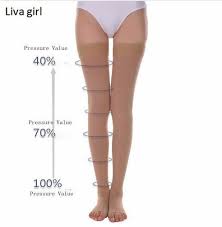
Increased Athletic Performance
Wearing compression socks during and post workouts will improve muscle recovery. Wearing the stockings will naturally alleviate lactic acid from building up and reduce wear and tear on the muscle.
Comfort
Lack of mobility when traveling or working may cause low blood flow and puts you at risk of dangerous blood clots. This is highly reduced when using support stockings.
Side Effects of Wrong Compression Strength
Because foot compression socks are intentionally tight, they can be difficult to wear them. The legs should be clean and dry before putting them on. If you have applied lotion on your skin, then make sure that it is absorbed completely before attempting to put on the socks.
Using compression socks can have the following side effects:
- Broken skin
- Skin irritation
- Discomfort
- Temporary dents in the skin
Wearing wrinkled, or incorrectly the stocking or the wrong size can cause these problems. When blood circulation is inhibited, then conditions such as neuropathy can damage the nerves in the legs.
You can also get negative results from wearing compression stockings for long periods. Removing the socks each day and check the feet for any signs of damage to the skin will help you avoid some of these side effects.
Conclusion

When searching for foot compression socks, make sure that you have all the facts right before ordering them. These socks offer a wide variety of benefits to users and using the wrong compression level can bring more harm than good. If unsure which compression strength is right for you, you can have your doctor recommend one for you. If you have certain medical conditions, the doctor will prescribe these socks. They will help you have improved blood circulation. following the above guide, you are sure to benefit from the support stockings.
This page last updated January 7, 2022
